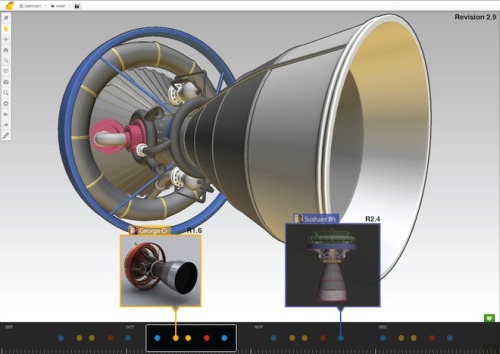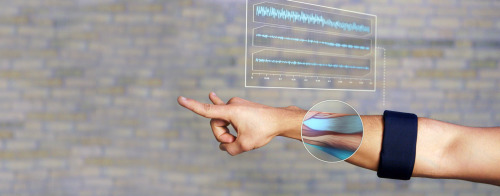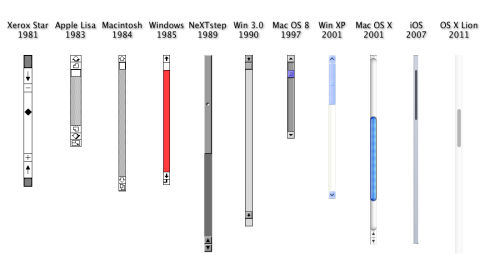Displair, a unique gadget at CES 2013, allows you to turn a misting wall of water vapor into a strange touchscreen. Here, Jason Gilbert from the Huffington Post plays a game of Fruit Ninja on a Displair.
Showing posts with label technology. Show all posts
Showing posts with label technology. Show all posts
Wednesday, March 13, 2013
Tech: Displair Water Vapor Touchscreen
Displair, a unique gadget at CES 2013, allows you to turn a misting wall of water vapor into a strange touchscreen. Here, Jason Gilbert from the Huffington Post plays a game of Fruit Ninja on a Displair.
Tuesday, March 12, 2013
Tech: 3-D Printing in Space
From 3D printed moonbases to architectural wonders more to down to Earth, as we saw what awesome mixture 3D printing and architecture could bring, I was left wondering about what other technologies we could be remixing 3D printers with. Partially answering my curiosity, Wired highlights an exciting new world of Rocket science.. now 3D print compatible? Apparently so!
Sure, a 3-D printed car is cool, but it doesn’t go to space. And there’s probably a good reason for that, but now a competition is aiming to launch the newest manufacturing fad into the final frontier by challenging people to design 3-D printed rocket engines.
Monday, March 11, 2013
Tech: iCub Learns Language
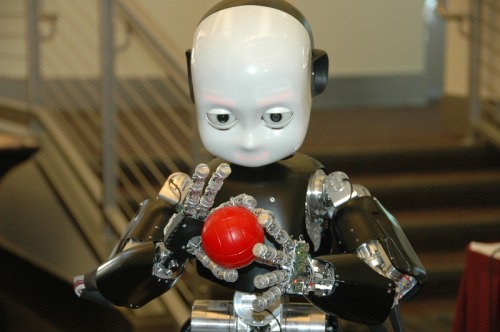
Not all would agree but I think this advancement in robotics could be a gigantic leap in the way artificial intelligence (A.I.) grows in future robots that will need some kind of advanced A.I. For instance, how do we suppose any sentient being with the capacity to learn..learns? Although it may not be the paramount function of robotics, communicating is definitely up there in the list of obstacles needed to be apprehended if we are to have competent robots making human interactions. For it is because of communication that we learn to pass on data, and language is a form of it.
Think of it this way, a robot that understands how language works and even knows how to use it, is a robot that has been given a new pathway to understanding. A pathway that we as humans have acquired and while we haven’t mastered it I believe we do have enough experience with it to imitate it and implement it in fields where it is most needed. What I really took from this article however is the fact that the researchers looked at how the brain actually works in order to mimic the way we form and understand language. This is how robotics ought to be looked at, we see our biological nature and mimic it to the best of our abilities using technology. Working with simpler versions while upgrading along the way.
Thursday, February 28, 2013
Tech: Wearable Gesture Controls
Motion Technology is certainly being pushed hard with the introduction of Leap Motion last year. This area of technology gives the regular user, an experience like that of Tom Cruise and there is a new addition to this futuristic market. Whilst many other devices use camera based gesture control, Thalmic Labs have offered another solution.
With the wave of your hand or a turn of your wrist, MYO will transform how you interact with your digital world. The MYO armband lets you use the electrical activity in your muscles to wirelessly control your computer, phone and other favourite digital technologies. A completely new approach to gesture controlled technology, the MYO monitors muscle activity by strapping around your forearm.
Wednesday, February 13, 2013
Study: Entertainment Devices

"In the 18- to 34-year-old demographic in particular, TV’s edge is slipping. Just 30% of that group said they expected TV to be their primary source of news and entertainment this year, with 28% saying it will instead be their laptop computer, and another 17% citing their smartphone."Source: emarketer.com
Tech: QR Codes Embedded into Sidewalk

"Rio De Janeiro has embedded QR codes into their sidewalks to help tourists learn more about the city and more easily get to where they are going. The codes have been embedded into the city’s traditional mosaic sidewalks in the form of black and white tiles. When the tiles are scanned with a smartphone, a local map and information is provided to the user in English, Spanish, or Portuguese. Brazil plans to embed roughly 30 QR codes at beaches, vistas and various historic sites around the city, helping Rio’s two million foreign visitors each year get around."
Source: enpundit.com
Tech: 10 Most Impressive Smart Cities

"It wasn’t too long ago that the term ‘Smart City’ was not on very many people’s radar screens, but today smart cities are popping up all over the place and people are becoming more familiar with what that entails. In case you’re not familiar with the term a smart city uses information combined with technology to improve quality of life, reduce environmental impact, and decrease energy demand. This list of the smartest cities on the planet takes those factors into consideration, as well as the ‘smart’ plans the city might have for the future."Source: freshome.com
Thursday, February 7, 2013
Video Distraction: Home Office of the 21st Century
In this 1967 clip from the CBS news series, The 21st Century, Walter Cronkite predicts what the home office of the year 2001 would look like. He was a bit off, but oddly enough, this is exactly how I always imagined my retro Bond-esque villain lair would look one day... except one of my walls will be a giant shark tank.
With equipment like this in the home of the future, we may not have to go to work. The work would come to us. In the 21st century it may be that no home will be complete without a computerized communications console.
Tuesday, December 11, 2012
Video: An Animated History of Nintendo
Paris designers Anthony Veloso and Quentin Dron of Retro Game Addict created this great animated Nintendo History timeline that takes us on an artistic journey from the Game & Watch handheld (1980) to the Wii U (2012).
Monday, December 10, 2012
Video: An Animated History of the iPhone
CNET UK created this wondeful animated history of the iPhone dedicated to the memory of Steve Jobs.
The iPhone might be at the cutting edge of technology but it took a long time and many innovations to get there, take a trip through history and explore the people and technology that contributed to the iPhone becoming what it is today.
Friday, November 16, 2012
Tech Links: November 16, 2012
Business
Are ‘second-hand e-books’ possible?
Taxing Amazon: An investigation
What's It Like To Work For Tim Cook? A Former Apple Sales Exec Dishes
Entertainment
Writing Poems With Google
Gadgets
"The Surface's Keyboard Cover Is Literally Coming Apart at the Seams." (Hard to believe, coming from the company that invented the red ring of death.)
Reading & Discussion
How a Robot Will Steal Your Job
I Am A Terrible Programmer. Some words of wisdom from Dan Shipper: "Like most things in life, the answer to what a good coder is, is somewhere in between the guy who wants to get it out fast and the guy who wants to make it beautiful."
No one disputes that the information age raises serious concerns where our civil liberties are concerned, but the ACLU takes paranoia to new heights when it imagines what it might be like to Order Pizza in the future.
Resources & Utilities
Sanebox Is Priority Inbox for Gmail Done Awesome
Tutorials
How to Commit Internet Suicide and Disappear from the Web Forever
How to: sell your old gadgets online
Two guides to actually keeping online communications secret.
Tuesday, October 30, 2012
Photo: Last Launch
Tech: A biology-friendly robot programming language

A biology-friendly robot programming language:
For researchers in the biological sciences, however, the future training of robots has been made much easier thanks to a new program called “PaR-PaR” (Programming a Robot). Nathan Hillson, a biochemist at the U.S. Department of Energy (DOE)’s Joint BioEnergy Institute (JBEI), led the development of PaR-PaR, a simple high-level, biology-friendly, robot-programming language that allows researchers to make better use of liquid-handling robots and thereby make possible experiments that otherwise might not have been considered. “The syntax and compiler for PaR-PaR are based on computer science principles and a deep understanding of biological workflows,” Hillson says. “After minimal training, a biologist should be able to independently write complicated protocols for a robot within an hour. With the adoption of PaR-PaR as a standard cross-platform language, hand-written or software-generated robotic protocols could easily be shared across laboratories.”
Source: Kurzweil
Friday, October 26, 2012
Tech: Feds Stay Ahead of the Robo-Car
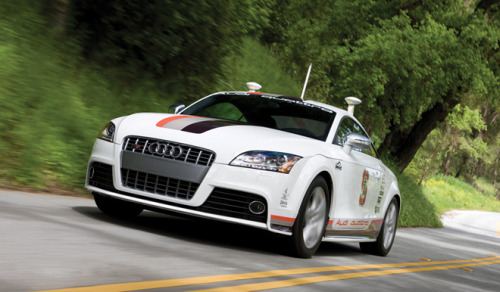
"Google and several automakers are creating a future in which we’ll cede control and let the robot drive. It’s a brave new autonomous world, with Google having logged over 300,000 miles in its fleet of autonomous hybrids, and Audi, BMW and General Motors all racing to bringing the technology to market. But with great changes comes greater regulation, and after recent legislation making autonomous cars legal in California, Nevada and Florida, federal regulators are attempting to stay ahead of the rapid rise of the robo-car.At a forum in Washington, D.C., NHTSA Administrator David Strickland laid out the agency’s wide-ranging and far-reaching intentions to implement testing and ultimately draft rules for autonomous vehicles. And at an event in Detroit last week, NHTSA’s director of crash avoidance and electronic controls research, Tim Johnson, announced that the agency will conduct a two- to three-year, $1.75 million research project in conjunction with Virginia Tech to study the real-world implications of autonomous vehicle technology."
Source: Wired.com
Thursday, October 11, 2012
Tech: Live2D
Live2D, developed by Cybernoids, is the world’s first drawing technology to enable 3D rendering of 2D images. This technology supports a variety of portable consoles and smartphones, and Live2D is already being utilized for games that take advantage of the unique characteristics of hand drawn artwork.Source: diginfo.tv
“In 3D, the unique attractions of 2D art like Osamu Tezuka’s can’t be rendered properly. But with Live2D, we’ve worked to enable smooth 3D motion using entirely the original 2D drawings. So, this system makes the graphics appear exactly as the creator intended.”
“When the face turns sideways, you can show perfectly how the eyelashes and eyes move. You can also use the tools to work more easily and efficiently. This can be done in all kinds of ways, with all kinds of emphasis, depending on what the creator wants to do. This technology is an extension of drawing, so it works best if the creator has a good artistic sense.”
Saturday, October 6, 2012
Lecture: Can We Have Brain-to-Brain Communication?
Some people think that the next big innovation in the coming decades is not going to involve the Internet because we can actually connect computers to the human mind. Therefore, Michio Kaku says this brain-to-brain communication would involve not just the exchange of information, but also the transmission of emotions and feelings, "because these are also part of the fabric of our thoughts."
Friday, September 21, 2012
Video: The First Film Shot With Google Glass
We've seen Google Glass, the project responsible for the filming, augmented-reality-providing glasses, jumping out of planes, but this is the first actual, edited film made with them. Diane Von Furstenberg's show at New York Fashion Week featured models wearing the glasses, and the designer herself wore them as well. The footage was edited into a pretty amazing insider look at how a runway show feels.
Photo: Space Shuttle Flight Decks
Space Shuttle Flight Decks by Ben Cooper
Via: Boing Boing
I’ve played enough video games during my tenure to safely assume that I could easily jump behind the joystick of one of these beauties and immediately be sailing at a smooth near-lightspeed. It’s gotta be that easy, right? My secret to success: mash every button until it does something you want. Ben Cooper took these absolutely gorgeous fisheye shots of the space shuttle flight deck interiors, with prints available at launchphotography, to post up on your wall and gaze longingly at.
Wednesday, September 19, 2012
Tech: Baxter Manufacturing Robot
Baxter is a new manufacturing robot designed to perform repetitive tasks normally done by unskilled labor while working "elbow-to-elbow" with human coworkers. Sonar and cameras allow the robot to detect humans in order avoid colliding with them. What's more, Baxter doesn't need to be programmed. He can be trained by simply walking him through the motion required to complete a new task. The hope is that Baxter's relatively low cost (US$22,000) will provide small business with an alternative to offshore manufacturing.
Subscribe to:
Posts (Atom)
